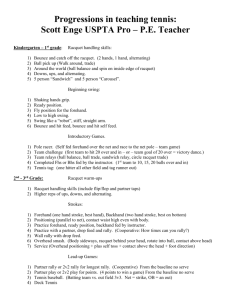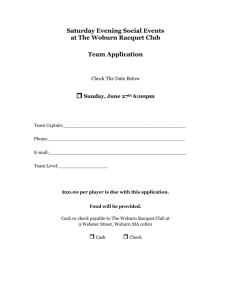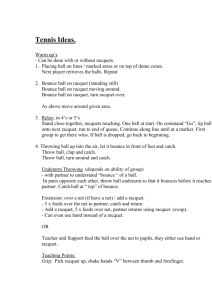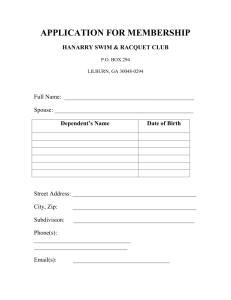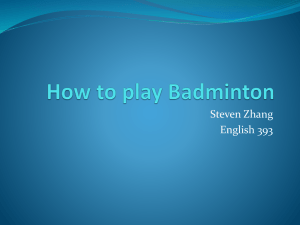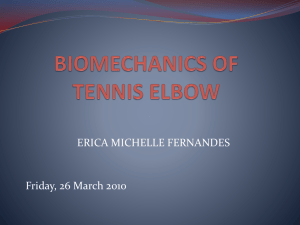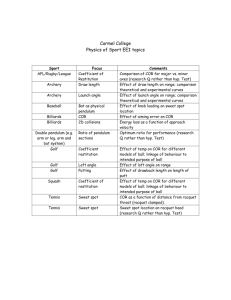An examination of the Forehand Stoke, specifically, the physics of
advertisement
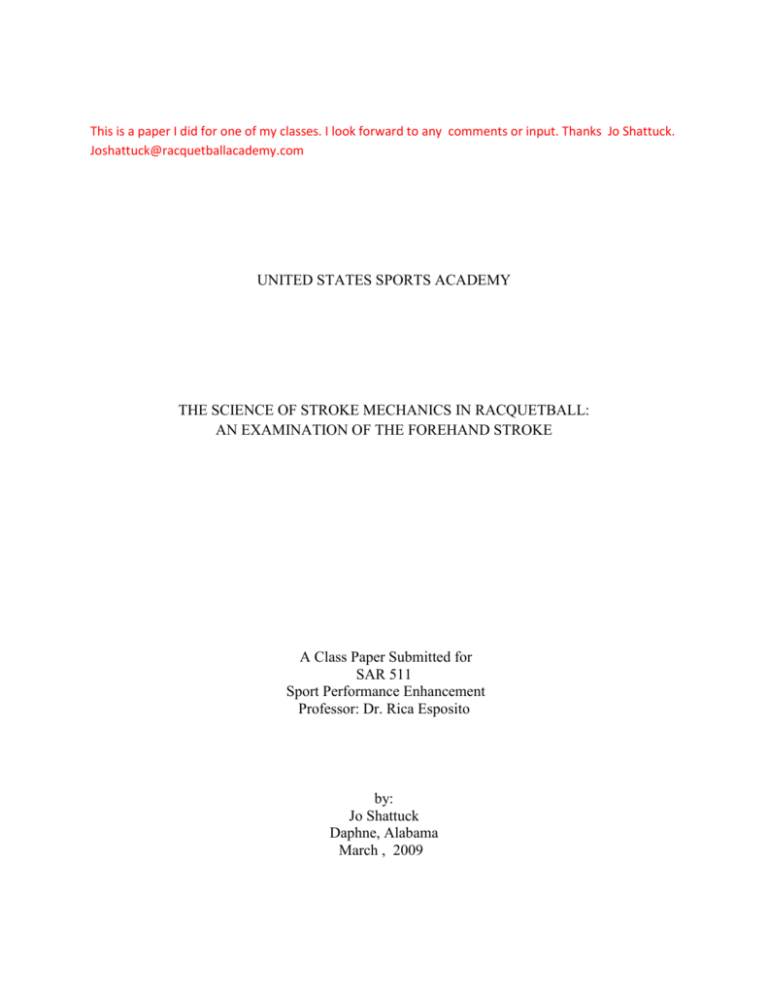
This is a paper I did for one of my classes. I look forward to any comments or input. Thanks Jo Shattuck. Joshattuck@racquetballacademy.com UNITED STATES SPORTS ACADEMY THE SCIENCE OF STROKE MECHANICS IN RACQUETBALL: AN EXAMINATION OF THE FOREHAND STROKE A Class Paper Submitted for SAR 511 Sport Performance Enhancement Professor: Dr. Rica Esposito by: Jo Shattuck Daphne, Alabama March , 2009 Table Of Contents Title Page ............................................................................................................................. i Section I. Introduction ....................................................................................................1 Purpose ..........................................................................................................2 In pursuit of improvement ..............................................................................2 Section II. Review of Information ...................................................................................3 Evolution of the Modern Stroke .....................................................................4 Physics of the Stroke ......................................................................................4 Analysis of the Stroke .....................................................................................6 Limitations of the Stroke .................................................................................8 Calculating Forces in the Stroke ....................................................................9 Section III. Summary and Conclusions ..........................................................................12 Common Mistakes……………………………………………………….…………12 Limitations of the paper ................................................................................14 References ………………. ..............................................................................................15 Appendices ………. ...........................................................................................................15 INTRODUCTION Purpose of the paper The sport of racquetball is almost forty years old and has been evolving ever since Joe Sobek made his first „paddle racquet‟(1). The stroke mechanic techniques used today in racquetball are different than they were when the game was first invented. Over the years, the strokes that are widely accepted to be proper have adapted to the new technologies and improvements in the racquets. In this paper, I discuss current stroke mechanics and compare them with the techniques of the past. Then, I illustrate the stroke by breaking it down into three phases and describe how each phase works by using the principles of Newtonian physics. I used the body measurements of a professional player to show how the forces are generated when using the proper technique to propel the ball. In Pursuit of Improvement At the end of the paper, I provide some ideas on how to improve power and control by manipulating various elements of the stroke, and then I provide information on common mechanical errors, explain why they are considered „errors‟, and I give their solutions. Players, coaches and anyone interested in bio-mechanics of human movement may find some value in the analysis. REVIEW OF INFORMATION Evolution of the Modern Stroke Modern fundamentally correct strokes are intended to be „flat‟, or rather, to minimize the risk of vertical error. The face of the racquet that hits the ball, (the string bed) is parallel to the front wall well before, during and slightly after contact with the ball. The degree of „flatness‟ of a stroke is reflected by how much distance through space the racquet head travels while the string bed remains perpendicular to the floor, and parallel to the side wall. Upon contact with the ball, the racquet rotates on its transverse axis, rotating from the point in the grip where the butt meets the palm of the hand. See FIGURE A. Transverse axis FIGURE A Longitudinal axis Physics of the Stroke The maximum energy exerted on a stationary ball depends on the mass (M) of the racquet head multiplied by acceleration (A) of the racquet head (F=MA.) The racquet head speed depends on multiple factors including the width of shoulders, length of the arm, range of motion (flexibility) of the shoulder, elbow and wrist, the weight and balance of the racquet and the coordination, skill and muscle composition (fast twitch vs. slow twitch) of the athlete. Since there are so many variables, each stroke can be fine tuned to fit the exact measurements and abilities of the athlete and racquet, while maintaining the goal of minimizing errors and reducing the most penalizing consequences. Skipping the ball is the most severe mistake; it causes immediate loss of rally(2). As in any skill, the goal is to maximum output of the desired affect while minimizing the work required to produce the output. The best strategy in racquetball is to develop both power and control. (Uncontrolled power is ineffective in a court with no „out of bounds”; while lack of power can be ineffective in a small –easily covered- court.) In the past, players used a pendulum swing, similar to a golf swing; the ball was hit close to the body, near the front foot, with the racquet rotating through its longitudinal plane (an up and down stroke.) This swing may have maximized power with the older wooden or aluminum racquets, but unless the angle of the racquet face was perfectly flat upon contact, the player would “skip the ball” (the ball hits the floor first- equivalent to not getting the ball over the net in tennis) or are „sky the ball‟ ( the ball is hit would be hit more than three feet high on its path to the front wall- giving the opponent an easy opportunity to win the rally, both of which are undesirable outcomes. A fundamentally correct swing, even when not perfect will keep the ball in play, (not skip) minimizing risk. In short, if you are going to mess up, mess up sideways instead of up and down. Analysis of the Stroke The figures below represent the top view of the 4 phases of the forehand stroke from left to right. The ball will be hit toward the front wall. Front wall FIGURE B 1) Hip shoulder rotation 2) Elbow drops 3) Wrist flops 4) Racquet moves last We can study the forehand stroke in 4 phases beginning with hip/shoulder rotation which we‟ll call phase 1. When this is almost complete, the elbow arc movement begins, phase 2. This is followed by the wrist arc, phase 3. And finally comes the racquet tip arc, phase 4. You can see the paths of movement of the racquet, elbow, wrist and shoulder (not in chronological order) in Figure C. Paths of movement from left to right: ( shown in dotted white line racquet, elbow, wrist, shoulder) FIGURE C The four arcs of movement all point in the same direction upon contact with the ball. They also meet the target point perpendicular to the front wall. The forehand stroke uses a series of three second class lever systems, with the axis of rotation always located between the force and the resistance. Figure D shows the direction of forces before the stroke begins (left) and after at the time of impact with the ball (right). FIGURE E shows yellow dots over the axis of each system. These four movements when performed in sequence can produce enough force to produce racquet head speed of over 130 mph, and consequently propelling a 1.4 oz racquetball to approximately the same speed. FIGURE D Direction of forces in the forehand stroke: (red arrows from left to right- shoulder, elbow, wrist, racquet head- in chronological order) FIGURE E Axis, or joints. Shoulder elbow, wrist, racquet head- in chronological order) Limitations of the Stroke Many coaches and players want to know how to hit the ball harder. One can ask, why not swing a heavier racquet? (Because more mass means more force to hit the ball harder). Imagine swinging a cast iron frying pan instead of a racquet. However, the greater mass takes more force to accelerate it. So having a heavier racquet may „come through‟ faster, but it will take a more effort to swing. More effort creates more fatigue, so reaction time is reduced along with racquet control. Since racquetball depends on fast reactions at very precise points in time, control of the ball is crucial. Having more power with a massive racquet doesn‟t offer an advantage because of the loss of control it creates. So what about making a bigger swing? Because applying the same force over a greater distance means more force to hit the ball ) Well, the racquet that travels a longer distance through space does not always equal more head speed, unless the forces can overcome the mass of the racquet quickly, within the range of movement. Since older racquets were heavier, overcoming their inertia took a longer path in space to get its mass moving, so the strokes took up lots of space, in space. However, the human body allows only a finite amount of space (the circumference of the rotating lever) through which the racquet head can move. Calculating Forces in the Stroke Let‟s look at the forces produces by a professional player who is 5‟ 5” tall, has 16” shoulder span, 24” arm holding a 22” racquet. We‟ll find the force of the stroke measured in Newtons, the impulse measured in Newton-seconds and the torque measures in foot pounds. The total length of the lever would be half the shoulder span-(measured from the spine) plus the arm and racquet = 8 + 24+ 19= 51” (allowing for 3 inches of overlap on the grip, and 1 inch of flexibility in the extension of the shoulder) Since the racquet head travels through a 90 degree arc from start to contact, with a 51” radius, it will be moving through an 80” arc of space. Arc of a circle = r * the central angle. (This assumes full extension throughout the swing until the moment of contact with the ball; we know this is not the case but it can be used as an approximate baseline. The total combined arc of movement will be larger with overlap of lever systems. One newton, N, is the force required to move a 1 lb mass at 32‟ ps/ps OR 384” ps/ps. So if the mass, M is 6 lbs, and the acceleration, A is 51” per .5 sec (the time it takes to swing up to contact with the ball, then converting the .5 second into whole seconds, A = (102” in per sec/sec) then F produced by the forehand swing = (6lbs) * ( 102 “ per sec per sec)= 7.05 Newtons (The formula for force is Force= Mass * Acceleration) The torque produced is 359.5 foot/pounds. 7.05 N * 51”= 359.55 foot pounds of torque (The formula for torque is T=f*d= in newton meters, foot pounds, or pound force feet) The impulse is 3.52 Newton-seconds (N-s) The formula for Impulse = force (N) * change in time (.5 sec) If this player executed a perfect FH stroke, it could deliver 7.05 Newtons which results in a 3.52 N of force and 359.5 foot-pounds of torque. In this conversion, this force would result in a racquet head speed of 114 mph. Velocity = v=v0 + at. Which for the purposes of this paper, translates into approximately 114 mph ball speed, not accounting the swing weight or mass distribution of the racquet, variations of contact on the sweet spot, or for ball compression, ball rebound, heat or noise energy waste. The maximum ball speed recorded for this athletes‟ forehand stroke is 90 mph. That means that the athlete, technically, is capable of adding 24 mph to their ball speed. We would need to study each lever system and find out which one was failing, let‟s see how to do this below. The arc of movements are broken down as follows: s=r* central angle (by converting angle of arc to radian) FIGURE C Wrist arc = 3”* angle 85 deg= s(distance of arc) Elbow arc = 11”* angle 30 deg= s(distance of arc) Shoulder arc = 9”* angle 80 deg= s(distance of arc) In FIGURE C, Shoulder, 9”, arc of 85 deg = 12.50” in distance of the arc Elbow, 11” arc of 40 deg= 5.75” Wrist 3 “ arc of 85 deg= 4.45” Racquet 19” arc of 85 deg = 28.18 “ ( not shown) Total distance 50.88 inches of lever end travel. Perhaps by increasing the range of each axis, and consequently increasing the flexibility of each joint, we can increase add some mph to the stroke. If the 2nd phase, the elbow, begins before the 1st phase reaches its maximum range of movement), the we lose that distance in space during which to accelerate the racquet. If the wrist arc begins before the elbow arc reaches its maximum speed, then we lose more energy. The arc of movement of the last phase, will always be 90 deg” with a 51” span from the center of the athlete‟s longitudinal axis- (the center of his spine) to his racquet tip. You can compare this analogy a baton handoff in a relay race. The runner without the baton wants to receive the baton while he is at moving maximum speed, at the same exact instant that the baton holder is also at maximum speed, so no speed is lost during the transfer. The „baton‟, in this case is the speed of the racquet head. SUMMARY AND CONCLUSIONS Common Mistakes There are several common mechanical mistakes made by players on the forehand strokes. One is stepping at a severe angle to the intended direction of the ball, see FIGURE F. In throwing or jumping the entry step, or base step, is in the direction of opposite the force. Proper use of human mechanics is to step with left leg to throw right handed. The entry step generally should be not exceed 20 degrees from the direction of the force you are applying. When a players steps at 45 degrees, they lose range of movement in the hips, and their force is not being applied in the direction of the ball, nor is it acting as a base from which to push. CORRECT STEP NOT CORRECT FIGURE F Step should be towards the intended direction of the force applied ...not toward the side wall. Another common mistake is bending over at the waist during the stroke. This leads to a pendulum swing, (discussed in the first section) and reduces the contribution of the lower body into the swing. Players must use the lower back muscles to support the torso while applying force to the ball. These lower back muscles are much smaller and weaker than the leg and hip muscles, so their output is lower. Another common mistake is to stiffen the wrist upon contact with the ball. Sometimes the player will try to help the swing, by „pushing‟ the racquet through with his wrist. Both of these actions reduce the speed at which the last lever, the wrist and racquet, goes through its range of motion. Even the most powerful wrist flexion muscles could not equal the force which a properly executed stroke generates. An extreme example compares snapping a flexible leather whip, versus snapping an inflexible piece of wood. The last common mistake is for the athlete to have his weight moving forward during contact. As you can see in Figure C, the 2nd ,3rd and 4th picture, the torso moves forward only slightly, then rocks back to provide a counter action for the rear side of the body to pull from. When the player only moves his hips linearly to the front wall, he is not engaging the lever system the most efficiently as he can. An extreme example of this would be loading a crossbow with an arrow, but then simply throwing the loaded bow at your enemy. There are other errors in the forehand stroke involving the placement of the ball in relation to the hips and the shoulders. These are addressed in „away from the ball‟ skills, as in moving to and tracking a moving ball. For the purposes of this paper, the forehand stroke was studied from a stationary position hitting a dropping ball, moving only linearly toward the floor at regular gravity speeds, 32‟ ps/ps. Limitations of the Paper Although the methods and physics used in this examination are based on sound principles, the results of this paper should not be considered to be precise measurements. There are multiple variables in every lever system and movement that could change the results, not to mention the combination of each lever system affecting each other, and the unknowns listed in the introduction, i/e. width of shoulders, length of the arm, range of motion (flexibility) of the shoulder, elbow and wrist, the weight and balance of the racquet and the coordination, skill and experience of the athlete, their composition (fast twitch vs. slow twitch) training regimen, etc. The general idea was to simplify the forehand stroke by using pictures to explain the phases of movement, the forces at work, and the basic measurements of force, torque and speed generated. With better equipment, super slow motion, cameras, and precise speed guns, perhaps with sensors places on the end of the levers, (racquet, wrist, elbow and shoulder) we could get much more accurate calculations compares to our basic measurements of approximate, angles, and masses, and distances. The important issue to emphasize here is the evolution of the forehand stroke matches the strategies of the game which changed because of better, more powerful lighter equipment. In conclusion, racquetball strokes in today‟s game need maneuverability balanced with power. This is what the principle the flat strokes does, it maintains control but adds power. REFERENCES: 1) Winterton, J. (2004). Racquetball Fundamentals. New York, NY Human Kinetics 2) AMPRO/IPRO (American Professional Racquetball Organization Instructor Certification Manual, 2002. International Racquetball Federation, Albuquerque, NM APPENDIX Formulas used: S= arc distance= r * central angle Force= Mass * Acceleration Impulse = Change in p = change in m * change in V Torque = Force*Distance Measurement methods: To measure the time lapsed from the stroke beginning to ball contact, I used slow motion video playback to determine the time elapsed. The bodily measurements (lengths of hand, wrist, forearm, arm and shoulder) of the athlete, Jo Shattuck , a WPRO Pro player, were taken at the Wellness Center at the Denver Athletic Club. Results showed she is 5‟5”, 120 lbs, and the weight of arm and racquet was 6 lbs. This was measured with a kitchen scale and hanging basket scale.
